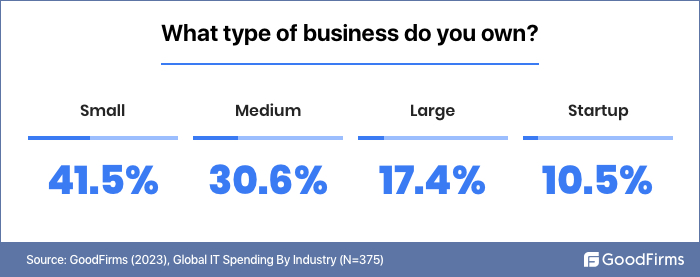ABSTRACT:
Information Technology (IT) plays a critical role in the day-to-day business operations across all industries. IT helps companies to automate processes, analyze data more rapidly, make more informed decisions, and mitigate risks. IT allows businesses to increase efficiency, productivity, and competitiveness.
IT spending varies across different industries due to differences in the nature of the businesses and the purpose of the technology. Healthcare and financial service sectors are indicated to have the highest IT spending. Global IT spending will increase over the upcoming years because of many factors, including the growing digitization of businesses and the necessity for enterprises to keep up with the quick pace of technological advancement.
GoodFirms survey titled: ‘Global IT Spending By Industry’ attempts to estimate the average spending across various IT industry segments. The research draws valuable insights from executives and IT professionals from various industries that can enrich the understanding of Global IT spending and its potential role in business operations in today's world.
Table of Contents:
Introduction
Top IT Investments Made by Organizations
Prime Factors Affecting IT Spending
IT Investment Key Areas
Top Reasons for IT Budgeting and Procurements
Significant Challenges that the Organization Encounters
IT Spending on Software Applications
Future of Organizations Investing in IT Infrastructure and Software Tools
Key Findings
Conclusion
Introduction
IT is an essential component for businesses to improve operational efficiency, enhance customer experience, and promote business growth. Companies must invest in IT software and systems to meet customers' demands and stay competitive in the fast-evolving digital era.
Global IT spending is the amount organizations spend on IT goods and services. This includes communication services, cloud services, software, and hardware. Most of IT spending is currently on laptops, printers, data center systems, CRM software, ERP software, AI, blockchain, etc. Global IT spending is expected to increase to 4.5 trillion U.S. dollars in 2023.(1) The main reasons triggering the rise of IT spending are the COVID-19 pandemic, the need for digital transformation, the latest technology updates, new project requirements, improved customer experience, business growth, and the increasing popularity of remote working.
GoodFirms' survey titled: ‘Global IT Spending By Industry’ aims to know about the current and future IT investment areas for businesses, top factors affecting IT spending, reasons for IT budgeting, major challenges that organizations encounter in IT budgeting, resource allocation, procurement and implementation, and what trends they want to capitalize on in 2023.
SURVEY AND DATA ANALYSIS
GoodFirms surveyed 375 businesses and enterprises globally to uncover the spending patterns of the companies that are advancing their business processes with the help of IT initiatives and identify trends in technology budgets.
Let us analyze the key survey findings:
Top Areas of IT Investments

PCs/Laptops
56.8% of the surveyed organizations say they have invested the highest in PCs/ laptops.
Many companies have invested in PCs and laptops for their employees due to the widespread adoption of work-from-home policies during and after the COVID-19 pandemic. The sudden transition to ‘work from home’ caused a surge in the sales of laptop and desktop computers; the sales exceeded 302 million in 2020.(2)
The trend continues in 2023 too. Employees now work remotely while still having access to the resources and tools they need to do their tasks. Investments in PCs and laptops have also aided businesses in maintaining the continuity of operations throughout the pandemic and in its aftermath too.
Servers
40.4% of the surveyed companies have made investments in servers.
Servers play an essential role in the organization's IT infrastructure as it helps boost productivity and lower business expenses. They also offer resources for businesses to carry out day-to-day operations, combating risk and storing data. Servers are also critical for running high-end industrial applications. Because of all these characteristics, servers are a crucial investment for every organization's IT infrastructure.
Cloud Services
32.4% of the respondents have invested in cloud-based services.
The worldwide cloud applications market is projected to reach $168.6 billion by 2025.(3) Cloud-based services help businesses share information, minimize human error and assist in making fast decisions. Cloud services are also more flexible than locally-hosted solutions. Therefore, an investment in cloud-based technology is critical for boosting productivity and working efficiently.
Other Hardware Devices
22.7% of the surveyed organizations like to make investments in hardware devices. 15.9% of surveyees particularly mentioned an investment in printers.
Hardware devices are crucial IT infrastructure. IT investments by companies in hardware devices help employees work effectively, boost productivity and sales, cost reduction, provide better customer support, and encourage employee collaboration.
Communications Services
20.5% of the surveyees have invested in communication services.
By investing in communication services, companies can enhance productivity, foster collaboration and communication among employees, suppliers, and shareholders, and speed up decision-making.
Business Process Software
19.1% of surveyed companies have invested in business process software.
Business process software enables companies to coordinate business processes with customer demands and aids executives in choosing how to allocate, monitor, and evaluate business resources. When business process software is effectively implemented, it improves effectiveness and productivity, saves costs, decreases mistakes and risks, and optimizes output.
Enterprise Software
10.2% of surveyed companies have invested in enterprise software.
ERP software assists enterprises in better employee communication and mostly focuses on productivity, improvements, and customer service. ERP also offers business intelligence capabilities to enhance business processes, including data mining, reporting, and decision support systems.
Data Center Systems
9.3% of the surveyees have made investments in data center systems.
Data center systems provide scalability and flexibility to businesses. They provide secure access to data and IT resources for the business. Therefore companies invest in data center systems to maintain their day-to-day operations.
System Development Services
7.5% of the respondents invested in system development services.
System development services are an investment made by businesses to enhance operations and acquire a competitive benefit. This may entail creating new applications to address particular business requirements, combining systems to enhance data flow and decision-making, and creating tailored software to automate tasks. Hence, investment in system development aims to boost productivity, efficiency, and revenue growth.
AI
4.2% of surveyed companies invested in artificial intelligence.
Implementing AI boosts productivity, assures security, fosters customer relationships and trust, boosts customer retention rates, expands data processing capabilities, gives businesses a competitive benefit in the market, optimizes management, and boosts reliability. Therefore investing in AI technologies ensures sustained business growth.
Blockchain
2.1% of surveyed companies have invested in blockchain technology.
Businesses may automate a number of processes with blockchain implementation, including payments, document verification, data management, and more. Businesses can save resources by letting operations self-validate their databases instead of using manual labor.
Prime Factors Affecting IT Spending Initiatives:
Aligning IT investments with business strategy is becoming a top goal for many CIOs across industries and sectors. Technology investments command the highest portion of corporate expenditures since IT is the foundation of most company processes.
IT investments are now the top priority of the corporate list as CIOs' responsibilities shift from value preservation to value creation.(4)
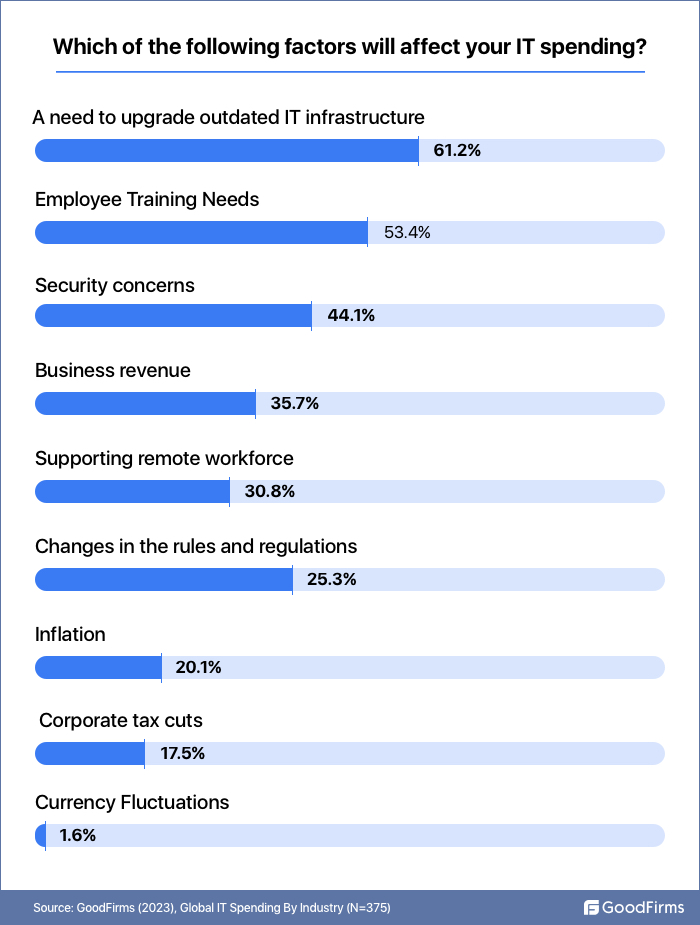
A need to upgrade outdated IT infrastructure
61.2% of the surveyees consider a need to upgrade outdated IT infrastructure as a primary factor affecting their IT spending.
Businesses may need to invest in upgrading outdated IT infrastructure and systems and updating the hardware and software frequently to ensure they are operating effectively and are capable of supporting the latest technology and business requirements.
Employee training needs
53.4% of the survey participants said training employees is a factor in their IT spending.
In 2022, the total spending on employee training by small-scale companies (employees between 100 and 999) spent around 1,400 US dollars per learner on training.(5) Employees need the training to understand how to use new software and technologies when they are implemented in the organization. This involves initial training for new systems when they are first installed and ongoing training to keep employees updated on the latest updates and features.
Security concerns
44.1% of the respondents feel security concerns are one of the reasons for an organization’s IT spending.
Investors show interest in those companies having a secure image. Customers like to purchase goods or services if they believe their data is private and safe with the company. That's why organizations are making investments in cybersecurity to create a safe environment for their customers and shareholders.
Business revenue
35.7% of surveyees consider generating business revenue as a factor in making IT investments.
Investing in IT is a great boon for companies as it helps businesses for maximizing their revenue generation. Companies that invested in business and technology operations saw five times faster revenue growth than those that did not.(6) Therefore, revenue generation is one of the prime factors affecting organizations' IT spending.
Supporting remote workforce
30.8% of survey participants do IT spending to support their employees working remotely.
Organizations will be compelled to bring forward plans for digital business transformation by at least five years through 2024. Those strategies will need to change for a post-COVID-19 environment when remote work and digital touchpoints are adopted more widely and consistently.(7)
As more companies are implementing remote working and supporting the infrastructure and technology required by remote workers, spending on IT is increasing. Companies are making investments in new software and technology to provide remote access to organizational systems and data. Laptops and pcs, collaboration and communication software, and cybersecurity are among the hardware and software that companies supply to remote workers.
Changes in the rules and regulations
25.3% of respondents consider changes in the laws and regulations as a reason for IT spending in their organizations.
Changes in rules and regulations may have a substantial impact on how much money businesses invest in IT. To guarantee that business activities adhere to rules, companies may need to invest in new technologies and procedures. Businesses also need to update or replace their current systems in order to comply with new regulations or industry standards. Therefore, keeping up with regulatory requirements and guaranteeing compliance requires significant IT spending.
20.1% of surveyees consider inflation a factor affecting an organization's IT spending, and 1.6% of survey participants said currency fluctuations affect their IT spending. Inflation and currency fluctuations can impact how businesses spend on IT since they may raise/lower the cost of goods/services and affect the pre-planned IT budget of the organization.
17.5% of respondents consider corporate tax cuts another factor in their IT spending. Corporate tax cuts can also impact IT spending as they can increase the availability of funds/ investments for IT resources and infrastructure.
76.4% of Surveyed Organizations Plan to Increase their IT Spending in 2023

Businesses are willing to invest in new hardware, software, and services to stay competitive and fulfill customer demands as technology develops and becomes an ever-more-important component of daily operations. The growing popularity of remote work and the shift to digital transformation are also the driving factors for increased IT spending.
Surveyed organizations revealed that though they see multiple economic headwinds ahead, their enthusiasm for investments in IT is far from over. They plan to increase their IT spending but will look for better deals with vendors, reduce non-essential spending, and reevaluate their existing contracts to shift to better technologies.
IT Investment Key Areas
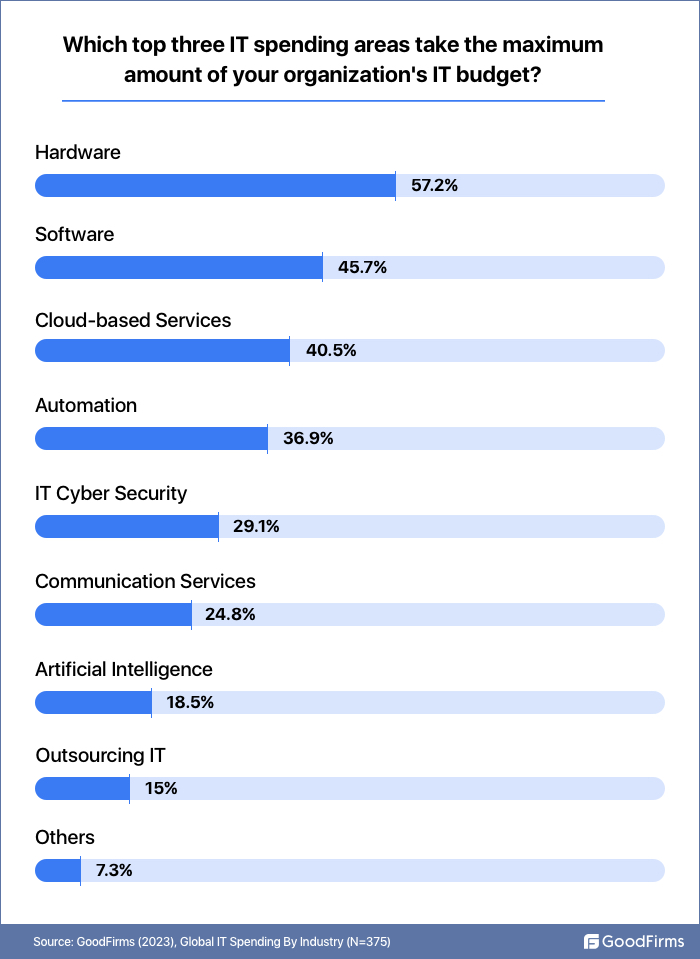
Hardware
57.2% of surveyed businesses allocate the highest portion of their IT budget to hardware
Depending on the organization's demands and technological infrastructure, the proportion of an organization's IT budget allocated to hardware can vary. However, one of the highest investment areas for IT departments is hardware (servers, storage systems, desktops and laptops/computers, printers, networking hardware, etc.).
Software
45.7% of the surveyed organizations set the highest portion of their IT budget aside for software purchases
Investing in software helps businesses in increasing business practices' efficiency, automate daily tasks, reduce costs, promote better customer service, and enhance the smooth flow of communication in the organization.
Cloud-based Services
40.5% of surveyed companies spend a significant portion of their IT budget on cloud-based services
Businesses these days prefer the flexibility and simplicity of cloud computing over conventional local hosting and on-premise software when it comes to data storage, processing, and collaboration. Around 60% of all corporate data is stored in the cloud.(8) Therefore, organizations benefit greatly from working in the cloud, including improved collaboration and simple access.
Automation
36.9% of the survey participants like to spend their IT budget on automation
Organizations spend their IT budget on automation to boost productivity, lower expenses, and increase efficiency. Organizations set their automation budget depending on the size of their operations and the automation projects being implemented.
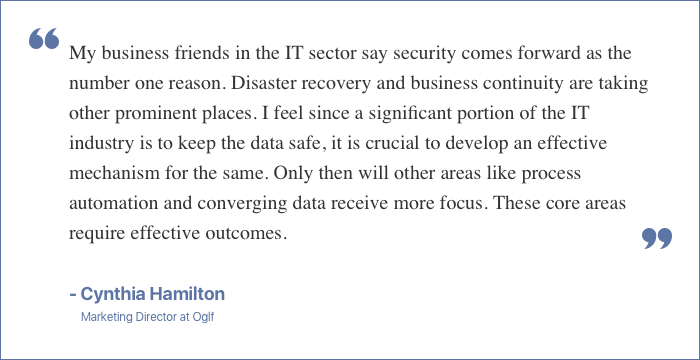
IT Cyber Security
29.1% of the surveyees spend a significant amount of their IT budget on cybersecurity
Businesses set aside a percentage of their IT budget for cybersecurity measures to safeguard their networks and data against cyberattacks. This can involve employee training, firewalls, antivirus programs, and intrusion detection systems. An organization may allocate a specific amount to cybersecurity depending on its size, the types of data it handles, and its risk profile.
Communication Services
24.8% of the surveyed organizations spend their IT budget on communication services to work together efficiently to remain competitive
Employees may effortlessly collaborate from any location, whether local or remote, with the help of communication services. It enables businesses to interact with customers effectively and provide high levels of customer service, which tempts organizations to spend a significant portion of their IT budget on communication services.
Artificial Intelligence
18.5% of businesses invest in AI because it boosts productivity by automating monotonous jobs, processing vast volumes of data, and helping produce forecasts
AI could contribute up to $15.7 trillion to the global economy in 2030.(9) AI assists businesses in gaining a competitive advantage by improving decision-making, cutting costs, and increasing the overall effectiveness of their operations. From content marketing and lead generation to business analytics and customer service, AI is aiding businesses in increasing their output, profitability, customer experience, and innovativeness.
Outsourcing IT
15% of businesses invest in outsourcing IT to increase productivity, cut costs, and concentrate on their core capabilities.
Enterprises invest in outsourcing IT as it helps in cost savings, provides access to specialist knowledge, and the opportunity to focus on core business operations. Outsourcing IT can give businesses more adaptability to meet changing business demands and technological advances. Hence, outsourcing IT can assist companies in more quickly scaling their operations and lowering the risk of disruptions.
According to Ataur Rahman, Founder & CEO of GetGenie
“My organization is planning to focus on increasing efficiency and streamlining processes in our IT spending for 2023. We aim to achieve this by implementing automation and utilizing artificial intelligence wherever possible. Additionally, we plan to increase our investment in cloud computing and virtualization to reduce costs and improve scalability. We also plan to prioritize cybersecurity measures to protect our data and systems. Overall, our goal is to maximize the value of our IT spending while minimizing waste and inefficiencies.”
57.5% of the surveyed organizations plan to spend around 20% to 40% of the overall 2023 financial budget on IT-related activities and purchases

The persisting global uncertainty around federal rate hikes, inflation, economic trends, political happenings, environmental risks, technological disruptions, etc., means companies need to be more prepared, agile, and versatile to keep their businesses on track. IT resources and technology can make businesses more resilient to ongoing changes. Therefore, organizations are putting high value and focus on IT investment. Their overall IT spending allocation is significantly higher than other areas in the financial budget.
The increasing use of IT resources in business, such as hardware devices, telecommunication services, IT software, data center systems, AI, etc., needs frequent updates and upgrades according to the latest versions, which require investments. As a result, organizations make a significant percentage of the IT budget out of the overall financial budget of the business.
Top Reasons for IT Budgeting and Procurements
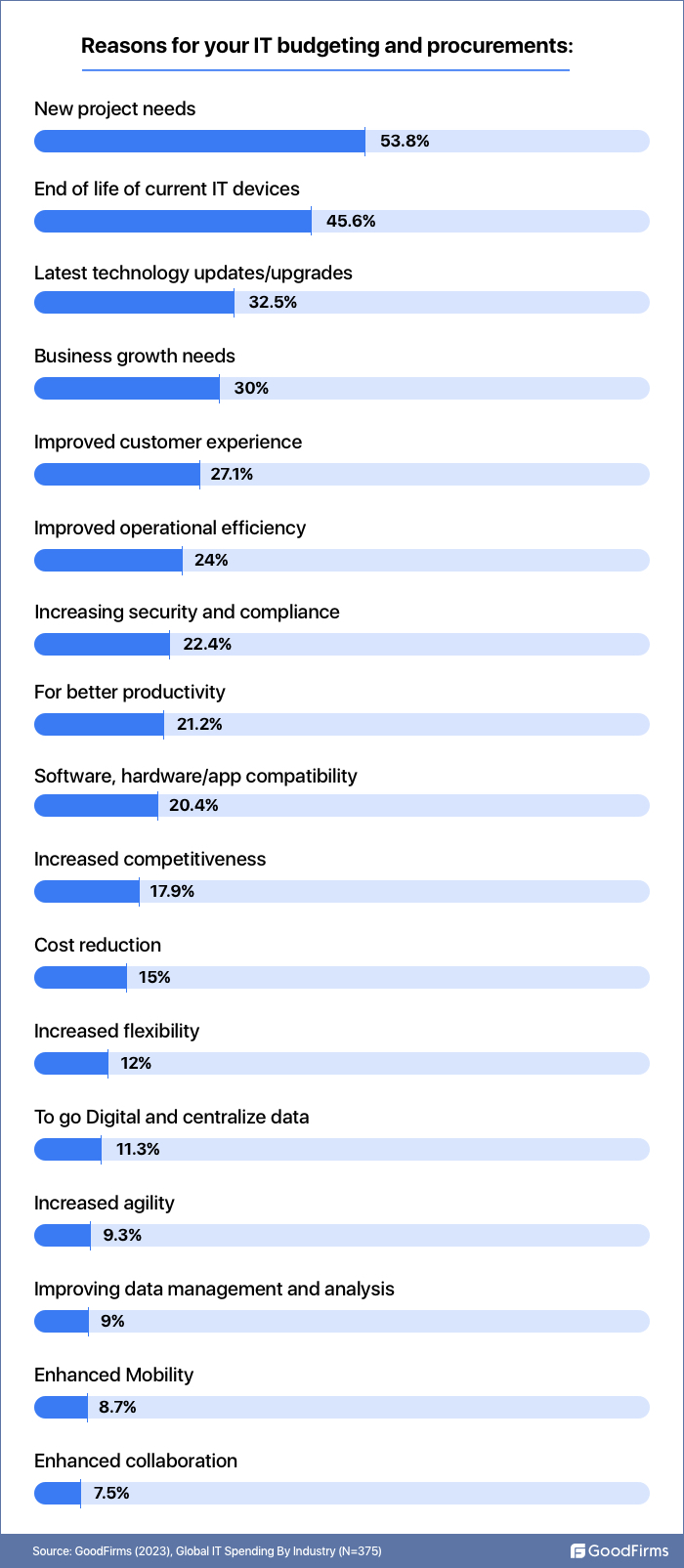
New project needs
53.8% of the surveyed organizations have a budget for IT procurement because of newly added projects and the demand for more resources. When a new project is started, organizations need to allocate a budget for any additional IT requirements related to it, and a significant sum is required for its design, communication, and implementation.
End of life of current IT devices
45.6% of the survey participants have a budget for IT procurement for replacing and updating the current IT devices. Organizations must replace outdated equipment with the latest models in order to preserve the effectiveness and dependability of their gadgets. Every business considers the end-of-life of devices as a crucial situation that requires IT budgeting.
Latest technology updates/upgrades
32.5% of the surveyed companies have a budget for IT procurement to do technology updates and upgrades. In order to keep up with the changing demands of business processes, organizations must maintain and modernize their IT hardware, software, and tech, which necessitates the creation of IT budgets.
Improved customer experience
27.1% of the surveyees have a budget for IT procurement to enhance customer service and experience.
IT tools help companies improve their customer satisfaction quotient by speeding communications, enhancing convenience, enabling self-serve choices, and implementing targeted marketing campaigns. However, IT budgeting is essential to allocate the optimal cash resources for such undertakings.
Business growth needs
25.6% of the respondents have a budget for IT procurement to meet their business growth needs. Companies use their IT budget to expand their businesses and to make sure they have sufficient resources to remain competitive and support organizational growth.
Improved operational efficiency
24% of surveyed companies have a budget for IT procurement to improve operational efficiency. Utilizing automation and technology helps companies increase their operational efficiency by removing the chances of human error occurrences that reduce efficiency.
Increasing security and compliance
22.4% of surveyed participants have a budget for IT procurement because of the need for increased security and compliance. IT security compliance helps maintain a company's reputation, keeps its activities legitimate, and assures the safety of an organization's data which overall impacts the organization's profitability.
For better productivity
21.2% of surveyees have a budget for IT procurement to enhance their productivity levels. Technology enables manufacturers to improve productivity, innovate quickly, save costs, and provide higher-quality goods to fulfill consumer demand. This boosts morale, fosters a culture of excellence inside the organization, and improves the working environment leading to increased employee performance.
Software, hardware/app compatibility
20.4% of surveyed participants have a budget for IT procurement to increase software, hardware/app compatibility. Organizations require to make investments in software, hardware, or applications that are compatible to carry out operations efficiently and effectively and for their regular updates and upgrades to prevent additional cost spending.
Increased competitiveness
17.9% of the surveyed organizations have a budget for IT procurement to stay competitive in the market. IT tools and hardware help organizations streamline their business processes, keep them updated about the latest trends, and stay competitive.
Cost reduction
15% of surveyed participants have a budget for IT procurement to reduce costs. IT budgeting helps companies in allocating resources judicially and also helps in minimizing wastage.
To go Digital and centralize data
11.3% of surveyed participants have a budget for IT procurement to go digital and centralize data. Digitization is one of the reasons for organizations to invest in the latest tools and technologies in order to automate business operations, provide better customer experience, and enhance efficiency.
Improving data management and analysis
9.3% of surveyed participants have a budget for IT procurement to improve data management and analysis. Companies are increasingly investing in data analytics and BI software to organize and secure their data systematically.
12% and 9.3% of surveyed participants have a budget for IT procurement to increase flexibility and legibility. Whereas 8.7% and 7.5% of the surveyed organizations have a budget for IT procurement to enhance mobility and collaboration.
66.2% of the Surveyed Organizations Expect an Increase in IT staff in 2023.

The increasing use of technology has driven the need for skilled IT professionals in every organization. Every organization requires IT professionals to study, develop, implement, manage, and maintain information systems, software applications, and IT hardware. Therefore, to meet the needs of technological advancements, organizations must hire IT staff each year.
Surveyed organizations believe that with an increasing focus on green initiatives and technological excellence as a differentiating factor for organizations in 2023, there will be a greater need for implementing IT infrastructure that is conducive to green measures and hiring more IT personnel to handle IT technology and tools. Most organizations are positive about new hiring in the IT domain of their organization.
Significant Challenges that Organizations Encounter while Purchasing New Hardware/Software
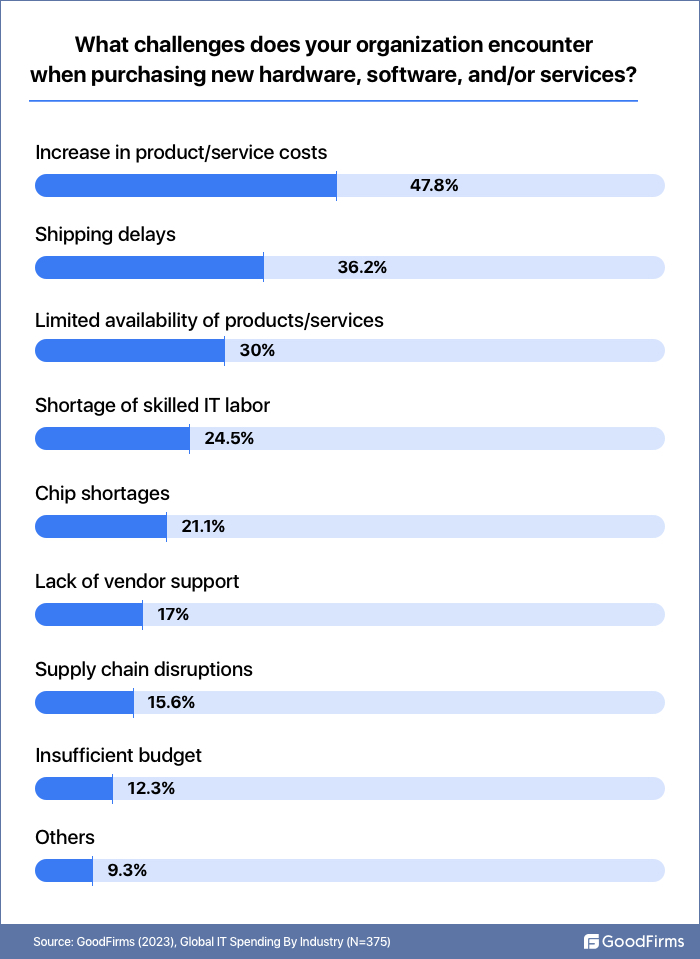
Increase in product/service costs
A steep rise in the cost of software and hardware stands as the top-most challenge for several businesses, and they believe that this has been impacting their IT budgeting to a greater extent. 47.8% of surveyees have quoted this as a prime reason. The rise in prices of products and services is the major challenge organizations face because IT budgets are being impacted by inflation, which drives up costs for products/services like hardware devices, software, servers, storage, and professional services.
Shipping delays
36.2% of surveyed organizations encounter shipping delays while purchasing products. “More than 40% of CFOs indicate supply chain shortages or delays have increased their companies’ costs by 5% or more, and 60% said their sales have either been reduced or will be by the end of the year as a result of supply chain disruptions.”(10) Shipping delays affect an organization in various ways, such as delayed delivery of any hardware or software can lead to delayed business processes and directly affect the productivity levels of both businesses and employees.
Limited availability of products/services
30% of the respondents say they face the unavailability of products or services while making their purchases. Companies generally struggle to manage supply risk, especially throughout the procurement process. Numerous problems affect the supply chain, such as the non-availability of products or services, rising costs, the possibility of fraud, and market or economic factors.
Shortage of skilled IT labor
24.5% of the survey participants consider the lack or shortage of qualified IT professionals a challenge. IT service experts monitor and resolve businesses' most challenging IT problems. Every organization needs an IT expert service provider that can effectively help monitor email and web hosting, data storage, server, and network maintenance, etc. IT professionals are also required to provide guidance and installation support while making purchases of hardware, software, or any service. The scarcity of skilled IT experts is one of the major issues that organizations face.
Computer chip shortages
21.1% of the surveyed organizations face a shortage of microchips. Many organizations and factories face a lack of computer chips, directly impacting their business continuity. The primary reason for chip shortages is the continued ban on some Chinese chip makers by the US government. Due to chip shortages, organizations have to cut or lower their production, while some have to stop their business activities temporarily.
Supply chain disruptions
15.6% of the respondents face supply chain disruption challenges as it directly affects the availability of IT resources, hardware devices, and software required to conduct business operations.
17% of the survey participants consider the lack of vendor support as a barrier while making purchases of IT resources and services. 12.3% of respondents say due to insufficient budget, they are facing difficulty in making purchases.
IT Spending on Software Applications

CRM Systems
40.7% of the surveyed organizations plan to spend their maximum budget on CRM software.
Companies invest in CRM systems because they assist businesses in storing customer data such as user activity, customer lifetime value, purchase history, and notes on sales interactions, etc., that can streamline sales and marketing operations and enhance customer service.
Project Management Systems
36.8% of the surveyed participants plan to use their budget on project management software.
Organizations use project management software to complete the project's requirements on time, assisting the team in planning, managing, and carrying out the task. Using a project management application, the team can easily communicate their ideas and progress on the job efficiently, organize all the project data at one location, and cooperate more successfully among themselves.
Document Management Systems
26.8% of the surveyed companies would like to spend their budget on purchasing document management software.
Companies invest in document management systems because they make it easier to store all business information and paperwork in one location and guarantee that all employees always have access to the same data. Hence, businesses investing in DMS can help save time and money. It offers centralized storage, audit trails, access control, document protection, and faster search and retrieval.
HR Tools
21% of the surveyed respondents plan to spend their budget on HR tools.
HR professionals can save time and money and manage their employees more effectively with the help of automation that is used by HR software. All essential HR processes, including hiring interviews and employee exit interviews, etc., can be managed by HR software.
Group Messaging and Video Conferencing Tools
19.4% of the surveyees will invest in group messaging and video conferencing tools.
Video conferencing tools provide businesses with many opportunities because the system is effective, affordable, and scalable to manage suppliers, collaborate across departments and locations, or engage remote employees.
Enterprise Resource Planning (ERP) Systems
15% of the survey participants find ERP software as the best investment.
Companies are investing in ERP software to scale operations, keep up with consumer demands, and optimize processes. ERP software helps organizations in speeding up customer service, simplify processes, consolidate data, and enhance teamwork.
Business Intelligence Platforms
12.5% of the surveyed companies will spend their budget on BI tools.
A business intelligence (BI) platform aids organizations in the collection, comprehension, and visualization of data. It is the foundation of a company's business intelligence strategy, which outlines how the organization will use data to improve decision-making.
Security and Compliance Software
10.2% of the surveyees will invest in security and compliance software.
The average cost of a company data breach was $4.35 million in 2022.(11) Companies spend their money, time, and resources to combat threats like malware, ransomware, and Denial of Service (DoS) assaults. Therefore, organizations are investing in security and compliance software to protect organization data and customer data from such threats and cyberattacks.
Supply Chain Management (SCM) Systems
5.3% of the surveyed organizations plan to make an investment in supply chain management (SCM) Systems.
Supply chain management systems enable organizations to monitor and control the effective transfer of finished goods and data from the point of manufacture through client delivery. The supply chain management software enhances the overall supply chain process.
It positively impacts the company's bottom line by automating repetitive operations, eliminating human error, lowering expenses, boosting customer satisfaction, and simplifying supply chain management.
9.9% of the surveyed organizations will spend their budget on cloud computing and infrastructure, and 8.6% of the survey participants will allocate a budget for data visualization software. Whereas 4.1% of the surveyed respondents will spend on predictive analytics tools.
Future of Organizations Investing in IT Infrastructure and Software Tools
79.6% of surveyees believe that investment in IT can help businesses solve challenges such as recession, hypercompetitiveness, pandemic, etc.
IT investments are helpful in mitigating the adverse effects of business challenges associated with hypercompetitiveness, slowdowns, and even unforeseen disruptions caused due to rare events like the pandemic. IT investment in businesses has become increasingly important to remain competitive and to stay up to date with the changing technology demand.

There are various benefits to investing in IT infrastructure and software, such as:
Solve business problems: IT investments can be beneficial in solving fundamental business problems like a pandemic-led disruption, hypercompetitive environment, and recession.
- IT investments during recessions assist many businesses in cutting expenses and boosting efficiency.
- IT investments provide businesses a competitive advantage in a highly competitive economy by enabling them to evaluate data and make more informed and better decisions.
- IT investments aided businesses in adjusting to remote work environments and helped in conducting their operations according to the pandemic, enabling them to keep operating efficiently.
Efficiency: A well-designed IT infrastructure aids organizations in boosting productivity, enhancing efficiency, cost savings, and providing a competitive advantage. Organizations must routinely monitor and assess their IT infrastructure so that it can fulfill their business demands.
Improved customer service: Companies are investing in information technology to provide their customers with better services and purchase experiences. Technology assists companies in every aspect of the customer purchasing journey, from placing an order to resolving queries that ultimately provide them with improved customer service and enhanced shopping experience.
Protect business data and stay compliant with regulations: Technology assists businesses in staying compliant with the rules and regulations. Companies invest in cybersecurity measures to protect their and customers’ confidential data from cyberattacks.
Stay competitive and remain profitable: Information technology and software provide organizations with a competitive advantage over their rivals in the market, which assists in staying competitive and profitable.
Here are a few examples of companies that have been benefiting from IT investments:
- Google: Google is one of the most dominant companies in the tech sector that has been making significant IT investments in data storage, cloud computing, AI, and search engines.(12)
- Netflix: Netflix ranks first among the OTT streaming platforms. Netflix is making high IT investments in data analytics and video streaming to provide users with personalized and original content.(13)
- Uber: Uber invested $500 million in the mapping system to provide better ride-sharing services. It has made significant IT investments in app development, mapping, and data analysis.(14)
Key Findings
- IT investment plays a vital role in allocating business financial resources for purchasing and implementing IT software, systems, solutions, and tools.
- 56.8% of the surveyed organizations say they have invested the highest in PCs/ laptops.
- 61.2% of the surveyees consider a need to upgrade outdated IT infrastructure as a primary factor affecting their IT spending.
- 53.4% of the survey participants said training employees is a factor in their IT spending.
- 44.1% of the respondents feel security concerns are one of the reasons for an organization’s IT spending.
- 40.4% of the surveyed companies make investments in servers.
- According to the GoodFirms survey, 76.4% of the survey participants reveal that they will increase their organization’s IT spending in 2023.
- Surveyed businesses spend 57.2% of their IT budget on hardware.
- 45.7% of the surveyed organizations set IT budgets aside for software.
- 40.7% of the surveyed organizations spend their maximum budget on CRM software.
- 53.8% of the surveyed organizations have a budget for IT procurement because of newly added projects and its demand for more resources.
- 66.2% of the respondents expect an increase in the overall number of IT staff in 2023.
- 40.5% of surveyed companies spend a significant portion of their IT budget on cloud-based services.
- According to the GoodFirms survey, 57.5% of surveyed organizations expect their total IT spending to be 20% to 40% of the overall 2023 financial budget.
- 45.6% of the survey participants have a budget for IT procurement for replacing and updating the current IT devices.
- 32.5% of the surveyed companies have a budget for IT procurement to do technology updates and upgrades.
- According to the GoodFirms survey, 66.2% of the respondents expect their organization’s overall number of IT staff will increase this year.
- 47.8% of surveyees deal with the rising prices of the products or services they want to purchase.
- 79.6% of surveyees believe that investment in IT can help businesses solve challenges such as recession, hypercompetitiveness, pandemic, etc.
- 36.2% of surveyed organizations encounter shipping delays while purchasing products.
- 79.6% of surveyees believe that investment in IT can help businesses solve challenges such as recession, hypercompetitiveness, pandemic, etc.
Conclusion
Digitization is not a choice but a necessity. With the growing technologies, companies should have a proper strategy to invest in them and stand ahead of their competitors. IT investments play a vital role in allocating business financial resources for purchasing and implementing IT software, systems, solutions, and tools. IT spending consists of costs for procuring, updating, and upgrading hardware devices, networking, services, software, and communication and collaboration technologies for IT professionals and training. The overall purpose of IT investments is to improve and streamline business operations, provide solutions to business problems, increase productivity and profitability, enhance customer experience, and provide businesses with a competitive advantage in the market.
Companies that hesitate to make investments in IT will suffer to stay up-to-date and maintain their position in the competitive market.
We sincerely thank our Research Partners for their valuable insights.
References
- https://www.gartner.com/en/newsroom/press-releases/2023-01-18-gartner-forecasts-worldwide-it-spending-to-grow-2-percent-in-2023
- https://fortune.com/2021/01/11/covid-computer-sales-lenovo-hp-dell-apple/
- https://www.appsruntheworld.com/top-10-cloud-software-vendors-market-size-and-market-forecast/
- https://deloitte.wsj.com/articles/it-spending-from-value-preservation-to-value-creation-1520830927
- https://www.statista.com/statistics/795795/training-expenditure-per-learner-and-company-size-us/#
- https://www.accenture.com/us-en/insights/technology/scaling-enterprise-digital-transformation
- https://www.gartner.com/en/newsroom/press-releases/2021-06-22-gartner-forecasts-51-percent-of-global-knowledge-workers-will-be-remote-by-2021
- https://www.statista.com/statistics/1062879/worldwide-cloud-storage-of-corporate-data/
- https://www.pwc.com/gx/en/issues/data-and-analytics/publications/artificial-intelligence-study.html
- https://www2.deloitte.com/us/en/pages/about-deloitte/articles/press-releases/supply-chain-disruptions-increased-costs-for-nearly-half-of-cfos-surveyed-in-the-third-quarter-deloitte-cfo-signals-survey.html
- https://www.tripwire.com/state-of-security/information-security-compliance-why-its-more-important-ever
- https://cloud.google.com/
- https://www.aidataanalytics.network/data-science-ai/articles/data-science-at-netflix-how-advanced-data-analytics-helped-netflix-generate-billions
- https://techcrunch.com/2016/08/01/uber-reportedly-invested-500-million-to-build-a-better-mapping-system/
Survey Participant Demographics
Firmographics:
The queried business owners, professionals, or executives comprise 27.5% of the IT and Technology sector, 18.1% provide professional services, 9.3% include the education sector, 7.6% are financial service providers and many more.
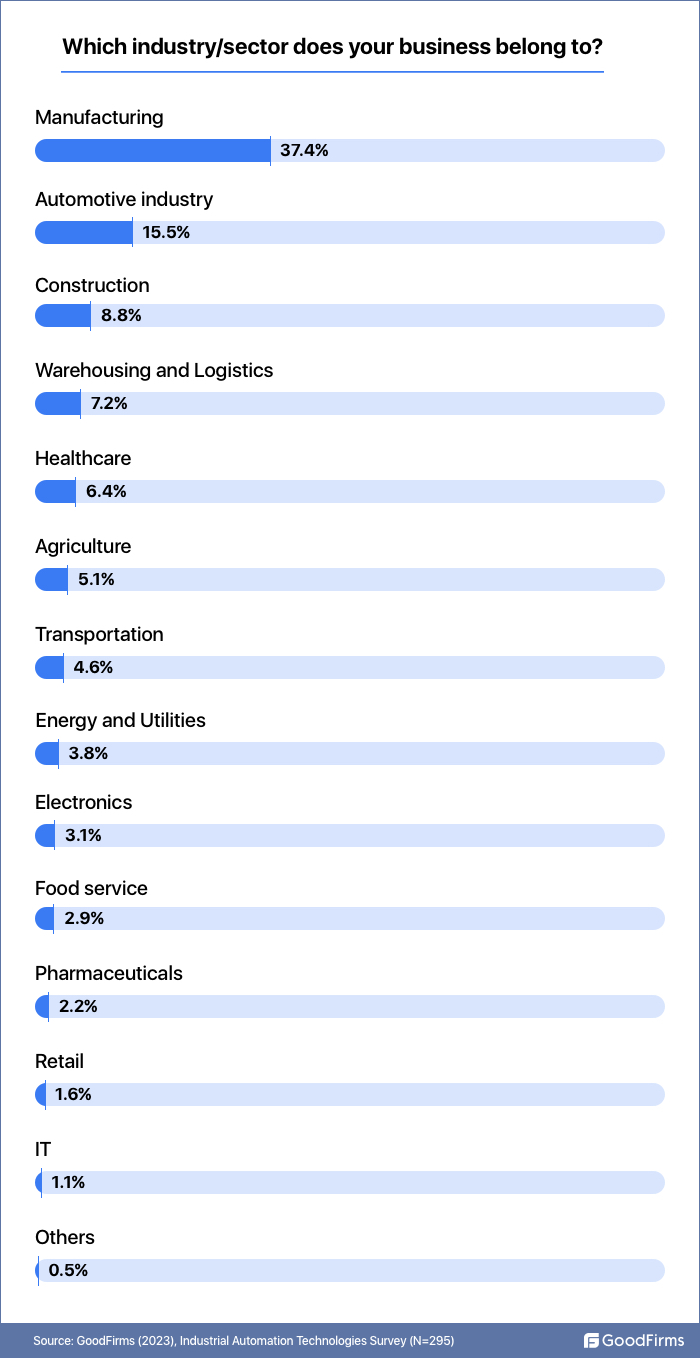
According to the GoodFirms survey, 41.5% of the participants have small businesses, 30.6% own medium-scale businesses, 17.4% of the surveyees have large-scale organizations, and 10.5% have started startup businesses.
